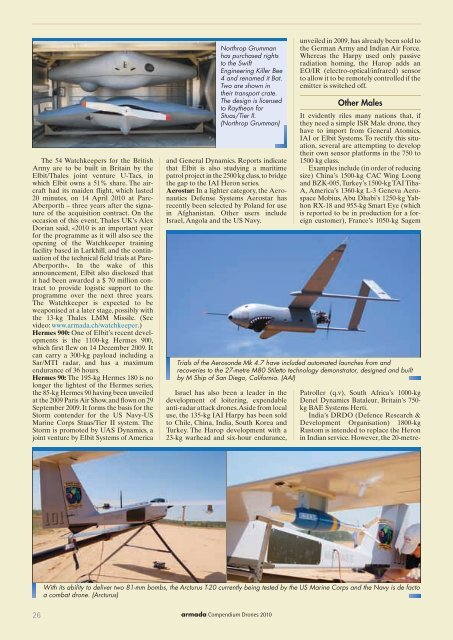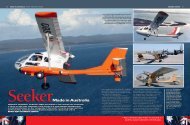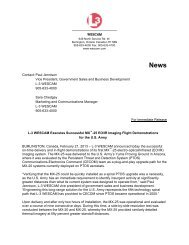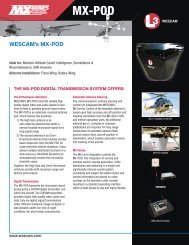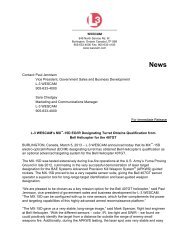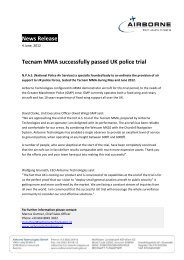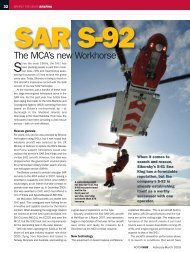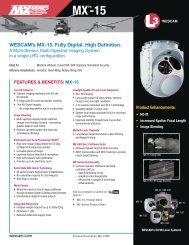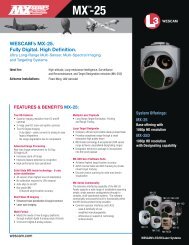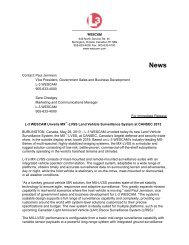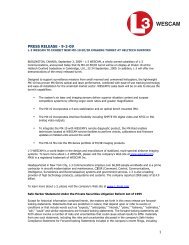Sensors - Wescam
Sensors - Wescam
Sensors - Wescam
Create successful ePaper yourself
Turn your PDF publications into a flip-book with our unique Google optimized e-Paper software.
The 54 Watchkeepers for the British<br />
Army are to be built in Britain by the<br />
Elbit/Thales joint venture U-Tacs, in<br />
which Elbit owns a 51% share. The aircraft<br />
had its maiden flight, which lasted<br />
20 minutes, on 14 April 2010 at Parc -<br />
Aberporth – three years after the signature<br />
of the acquisition contract. On the<br />
occasion of this event, Thales UK’s Alex<br />
Dorian said, «2010 is an important year<br />
for the programme as it will also see the<br />
opening of the Watchkeeper training<br />
facility based in Larkhill, and the continuation<br />
of the technical field trials at Parc -<br />
Aberporth». In the wake of this<br />
announcement, Elbit also disclosed that<br />
it had been awarded a $ 70 million contract<br />
to provide logistic support to the<br />
programme over the next three years.<br />
The Watchkeeper is expected to be<br />
weaponised at a later stage, possibly with<br />
the 13-kg Thales LMM Missile. (See<br />
video: www.armada.ch/watchkeeper.)<br />
Hermes 900: One of Elbit’s recent developments<br />
is the 1100-kg Hermes 900,<br />
which first flew on 14 December 2009. It<br />
can carry a 300-kg payload including a<br />
Sar/MTI radar, and has a maximum<br />
endurance of 36 hours.<br />
Hermes 90: The 195-kg Hermes 180 is no<br />
longer the lightest of the Hermes series,<br />
the 85-kg Hermes 90 having been unveiled<br />
at the 2009 Paris Air Show, and flown on 29<br />
September 2009. It forms the basis for the<br />
Storm contender for the US Navy-US<br />
Marine Corps Stuas/Tier II system. The<br />
Storm is promoted by UAS Dynamics, a<br />
joint venture by Elbit Systems of America<br />
Northrop Grumman<br />
has purchased rights<br />
to the Swift<br />
Engineering Killer Bee<br />
4 and renamed it Bat.<br />
Two are shown in<br />
their transport crate.<br />
The design is licensed<br />
to Raytheon for<br />
Stuas/Tier II.<br />
(Northrop Grumman)<br />
and General Dynamics. Reports indicate<br />
that Elbit is also studying a maritime<br />
patrol project in the 2500 kg class, to bridge<br />
the gap to the IAI Heron series.<br />
Aerostar: In a lighter category, the Aeronautics<br />
Defense Systems Aerostar has<br />
recently been selected by Poland for use<br />
in Afghanistan. Other users include<br />
Israel, Angola and the US Navy.<br />
unveiled in 2009, has already been sold to<br />
the German Army and Indian Air Force.<br />
Whereas the Harpy used only passive<br />
radiation homing, the Harop adds an<br />
EO/IR (electro-optical/infrared) sensor<br />
to allow it to be remotely controlled if the<br />
emitter is switched off.<br />
Other Males<br />
It evidently riles many nations that, if<br />
they need a simple ISR Male drone, they<br />
have to import from General Atomics,<br />
IAI or Elbit Systems. To rectify this situation,<br />
several are attempting to develop<br />
their own sensor platforms in the 750 to<br />
1500 kg class.<br />
Examples include (in order of reducing<br />
size) China’s 1500-kg CAC Wing Loong<br />
and BZK-005, Turkey’s 1500-kg TAI Tiha-<br />
A, America’s 1360-kg L-3 Geneva Aerospace<br />
Mobius, Abu Dhabi’s 1250-kg Yabhon<br />
RX-18 and 955-kg Smart Eye (which<br />
is reported to be in production for a foreign<br />
customer), France’s 1050-kg Sagem<br />
Trials of the Aerosonde Mk 4.7 have included automated launches from and<br />
recoveries to the 27-metre M80 Stiletto technology demonstrator, designed and built<br />
by M Ship of San Diego, California. (AAI)<br />
Israel has also been a leader in the<br />
development of loitering, expendable<br />
anti-radar attack drones. Aside from local<br />
use, the 135-kg IAI Harpy has been sold<br />
to Chile, China, India, South Korea and<br />
Turkey. The Harop development with a<br />
23-kg warhead and six-hour endurance,<br />
Patroller (q.v), South Africa’s 1000-kg<br />
Denel Dynamics Bataleur, Britain’s 750-<br />
kg BAE Systems Herti.<br />
India’s DRDO (Defence Research &<br />
Development Organisation) 1800-kg<br />
Rustom is intended to replace the Heron<br />
in Indian service. However, the 20-metre-<br />
With its ability to deliver two 81-mm bombs, the Arcturus T-20 currently being tested by the US Marine Corps and the Navy is de facto<br />
a combat drone. (Arcturus)<br />
26 armada Compendium Drones 2010


